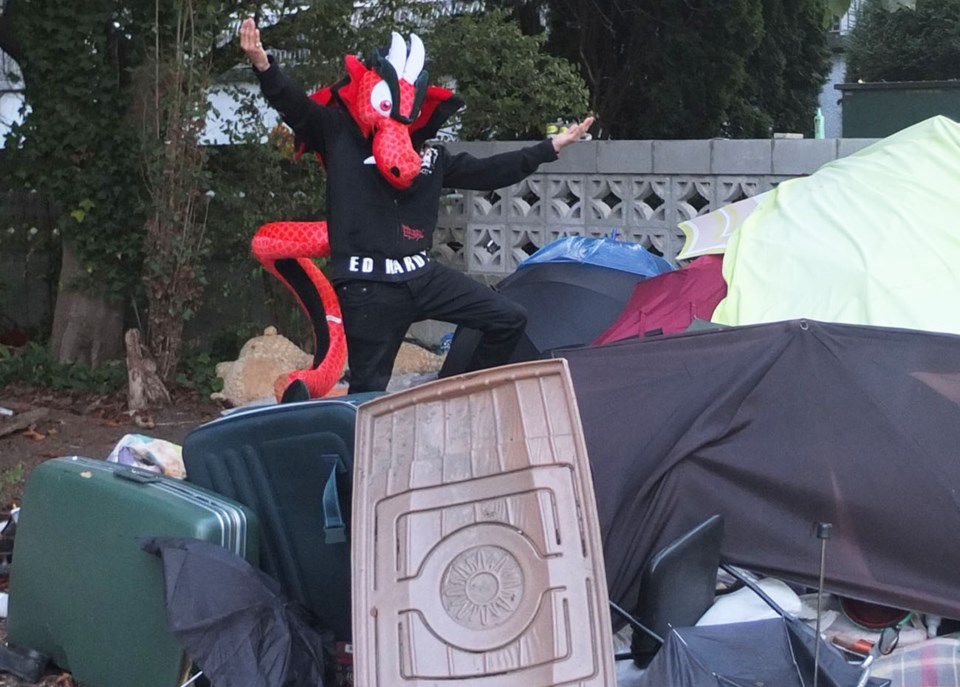A young homeless couple in their early 20s are attracting attention in the neighborhood near Cooney and Saba roads after moving into the area last month.
“It’s getting cold and rainy, I’m a bit concerned about their health,” Shenwei Wang, a resident living in a building nearby, told the Richmond News.
“If some unexpected tragedy happened to these homeless youths, it would be a pity.”
The young couple dress well and look bizarrely out of place in their “home,” which is comprised of stacked suitcases, open umbrellas and a sheet of green plastic, tucked into a corner of a vacant building lot near Brighouse Station.
“(The ‘home’) is waterproof, skunk-proof, and the dragon doll scares raccoons away,” joked the young man, who did not want to give his name for fear he would be identified by family members or friends.
“Many people say I don’t look homeless; it’s true, I'm not supposed to be here,” he said.
“I keep my head down when people walk by…I feel embarrassed.”
He told the News he and his partner have both been living on the street for almost a year since his parents kicked him out of the family home "after something happened."
The man said he’s working as an on-call laundry person, while his girlfriend is unemployed.
“She goes panhandling sometimes but I ask her not to...ask for food instead.”
He said they’ve been living on food given out by nearby restaurants and food court owners, and showering in community facilities.
“And (shower) in rain, it rained this morning,” he laughed.
“We have the money (a government rental subsidy), but can’t find a place,” said the young man.
“I have been applying for houses, going to view places, but never heard back from the landlord. Now I don’t feel motivated.”
The couple pondered moving to a shelter but they didn’t seem to be aware of what was available.
“Before, I was concerned, but now I have reached a point that, nah, it’s OK to live here, I guess,” added the man.
Homeless population keeps growing
The young homeless couple are a snapshot of the growing homeless population in Richmond.
The 2017 count of homeless people published Tuesday by Metro Vancouver revealed that Richmond has a homeless population of 70, of which 29 are unsheltered.
This includes 10 children and youth (under 25), and 15 seniors. Most people said they had been homeless for more than one year (41).
The figure is an 84 per cent rise compared to the last count in 2014 (38) and is the highest since 2005, when the count was first conducted.
“It (the growth of homeless people) is no surprise,” said Ted Townsend, city spokesperson.
“The affordability of housing in the region is really putting pressure on people, particularly those with limited income, and is contributing to the continuing growth of homelessness.”
Almost half of the survey respondents mentioned high rental rates and a lack of income as the major factors fuelling homelessness.
In fact, more than 20 per cent of the surveyed homeless people have a part-time or full-time job.
Addiction and mental illness are also factors, with 82 per cent of respondents dealing with at least one health condition.
However, the real number of homeless population in Richmond may be much higher.
Non-profit housing and service providers estimate that there are currently more than 120 homeless individuals in Richmond.
“Our (Richmond) shelter turns away 130 people each month,” said Deborah Lowell, communications and marketing director at The Salvation Army B.C.
Demand outstrips supply
The Salvation Army Richmond House at 3111 Shell Road is the only homeless shelter currently available in Richmond, offering 10 beds to male applicants only and no capacity to host those with disabilities.
Lowell noted that female homeless individuals may seek accommodation in the city’s domestic abuse care centre, Nova House.
Earlier this month, the City of Richmond and BC Housing announced that the Salvation Army is to receive an expanded facility on 12040 Horseshoe Way next year, after the lease of its current shelter runs out.
The new shelter will have 36 beds for both men and women, and people with disabilities.
“We have a development plan for each individual who comes to the shelter, to help them go back to regular rental housing within six months, in an ideal situation,” said Lowell.
At the same time, the city is updating its affordable housing strategy, which includes new policies to build more affordable housing for people who are most at risk in terms of being homeless, according to Townsend.
“At the end of the day, the demand is outstripping the supply,” said Townsend.
“Addressing homelessness and affordable housing does not have a simple solution, it’s not something the city, by itself, can resolve.
“Running shelters is very expensive. We need to work with community partners, and need funding from the provincial and federal government,” Townsend added.
According to the city’s Emergency Services and Transitional Housing report released in 2015, it costs $1,932 per month for a sheltered bed.
Lowell recommended the homeless individuals contact The Salvation Army to talk about their situation and needs.
“We’ll see what we can do now, if we can’t provide a bed.”
The city said a new Homelessness Needs Strategy of the city will be updated in 2018, after its last review in 2002.



